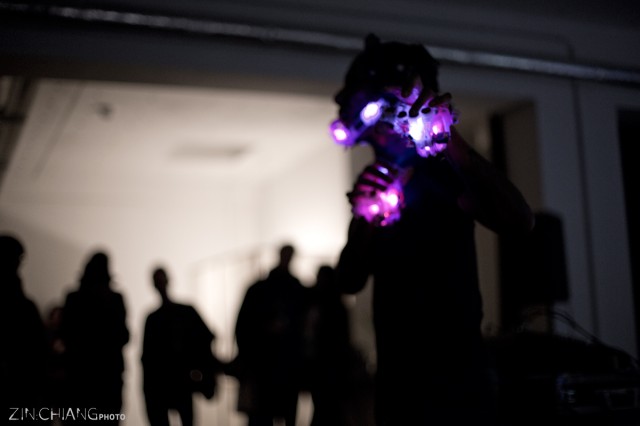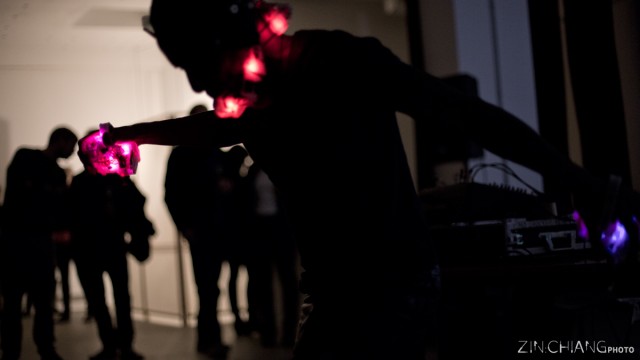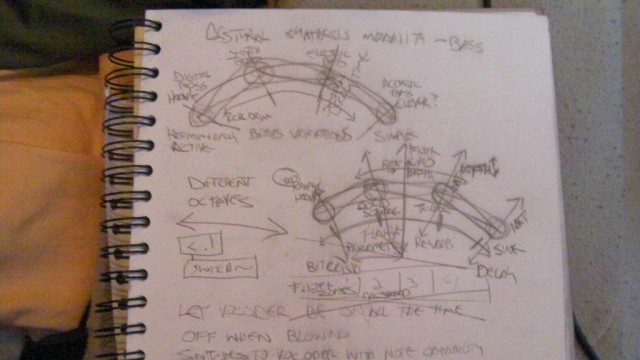
The man who fell to Earth: Onyx Ashanti’s open source hardware/software rig goes beyond computer and acoustic interfaces, alike, in a cyborg-style, enhanced human performance rig. Photo Zin Chiang, at CDM’s recent Open Source Music showcase at Retune, Berlin.
Onyx Ashanti can wail on a computer with no computer in sight, jamming on a virtual horn that has vanished into his cyborg-like live rig. Mouthpiece and head-mounted prosthesis replace what might have been a virtual reality helmet – or sax reed. Sensors in his hands provide more expression. But this isn’t just some flash and theater, while a laptop dutifully plays back loops. It’s really an interface to performance, both surfing samples and providing live solo lines improvised in real-time, in mid-air.
For a sense of what I mean, check out the party hosted by Berlin’s Mindpirates, at an event entitled “BlackDynomite,” from last week. (Video: Lars Beyer, Dholl)
We’ve followed Onyx’s work for some time, but that’s all the more reason to keep following it. Each time I see Onyx, he has iterated. Years ago, he was just playing an Akai wind controller and FL Studio. Then, year by year, he evolved, as if he’d been hanging out weekends with the Borg. Not all of these evolutions has been forward – the transition to Pure Data was initially a tough one, as the free tool’s learning curve took its toll. But now, a fully open-source hardware and software rig is making extraordinary sounds. And he has to literally work out to make this happen – body and brain, musical imagination and Pd chops, all need to be in top form.
There’s a mission here. At a workshop I gave at Berlin’s Kater Holzig last weekend, hosted by DE:BUG, one person sheepishly raised a hand. They wondered how my set with Pd sounded … well, nice. Apparently they’d heard too many experimental, squelchy sets, full of screeching noise. (Not that there’s anything wrong with that.)
When I hosted Open Source Music here in Berlin, Onyx joined other artists using DIY tools in ways that genuinely expanded expression – and still kept people dancing. Onyx demontrates that open source technology need not always yield the same music. Here, sharing is just a means to the level of technological pace he desires, a cultural accelerator. And people dance to his music – partly because he dances while making his music.
Onyx’s set really is with a computer, but freed from the confines of the folded display and keyboard, he can make performance a full-body experience. With 3D-printed gear on his head and hands, he not only makes the object of the computer dissolve, but the conventional instrument, too.
Here in some videos and images, you can see what’s going on. And this really is all Pd – analyzing sensor inputs and visualizing performance in a heads-up display that seems straight out of The Last Starfighter. (Kids, ask your pare– oh. Oh, God.)
Practicing performance and practicing software/hardware engineering are not separate activities. Each tweak to the patch means more musical expression. For instance, in the video below, Onyx works with time-stretching capabilities – a big part of what is enabling the rest.
Pd’s sound generation facilities, and original, home-brewed patches, now replace what had been proprietary software. Sharing isn’t just about philosophy – shared patches are forming a lexicon of sonic ideas, with artists build on others’ work gradually in the way musicians might riff off one another’s licks.
DIY2 [forum | download link] and rjlib figure in Onyx’s work.
Onyx is busy continuing to refine this rig. But I hope we get to revisit his work soon – supported in part by crowd-funding from CDM readers – and better understand how he has made these tools work.

